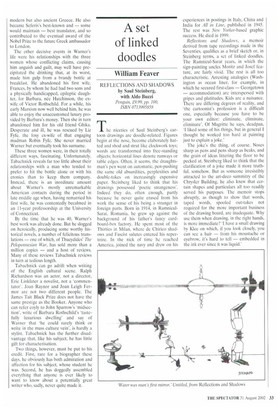A set of linked doodles
William Feaver
REFLECTIONS AND SHADOWS by Saul Steinberg, with Aldo Buzzi Penguin, 0.99, pp. 100, ISBN 0713995858 The niceties of Saul Steinberg's cartoon drawings are doodle-related. Figures begin at the nose, become elaborately hatted and shod and strut like clockwork toys; words are transformed into free-standing objects; horizontal lines denote runways or table edges. Often, it seems, the draughtsman's pen went an automatic, pen-pushing the same old absurdities, perplexities and double-takes on increasingly expensive paper. Steinberg liked to think that his drawings possessed 'poetic strangeness'. Indeed they do, often enough, partly because he never quite erased from his work the sense of his being a stranger in foreign parts. Born in 1914, in RamniculSarat, Romania, he grew up against the background of his father's fancy cardboard-box factory. He spent most of the Thirties in Milan, where de Chirico shadows and Fascist salutes entered his repertoire. In the nick of time he reached America, joined the navy and drew on his
experiences in postings in Italy, China and India for All in Line, published in 1945. The rest was New Yorker-based graphic success. He died in 1999.
Reflections and Shadows, a memoir derived from tape recordings made in the Seventies, qualifies as a brief sketch or, in Steinberg terms, a set of linked doodles. The Ramnicul-Sarat years, in which the sign-painting uncles Moritz and Josef feature, are fairly vivid. The rest is all too characteristic. Arresting analogies (Washington as ocean liner, for example, in which he secured first-class — Georgetown — accommodation) are interspersed with gripes and platitudes. Kids are a nuisance. There are differing degrees of reality, and the cartoonist's profession is a difficult one, especially because you have to be your own editor: eliminate, eliminate, eliminate'. Of Magritte he says, deadpan, liked some of his things, but in general I thought he worked too hard at painting just to explain a joke.'
The joke's the thing, of course. Noses sharp as pens and pens sharp as beaks, and the grain of ideas littering the floor to be pecked at. Steinberg liked to think that the clarification of a joke made it more truthful, somehow. But as someone irresistibly attracted to the art-deco summitry of the Chrysler Building, he also knew that certain shapes and particulars all too readily served his purposes. The memoir stops abruptly, as though to show that words, taped words, spooled out-takes not required for the more important business of the drawing board, are inadequate. Why use them when drawing, in the right hands, is more immediate? 'I have a small drawing by Klee on which, if you look closely, you can see a hair — from his moustache or eyebrow, it's hard to tell — embedded in the ink ever since it was liquid.'


























































 Previous page
Previous page